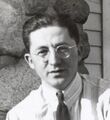Template:Selected anniversaries/June 3: Difference between revisions
No edit summary |
No edit summary |
||
| Line 16: | Line 16: | ||
||1868: Aristides Agramonte y Simoni born ... pathologist and bacteriologist who was a member of the Reed Yellow Fever Board of the U.S. Army that discovered (1901) the role of the mosquito in the transmission of yellow fever. In May 1898, he was appointed Acting Assistant Surgeon in the U.S. Army. Agramonte had acquired immunity to yellow fever from a mild childhood case in Cuba before emigrating to the U.S., which was an advantage when he was chosen by the Surgeon-General to study the yellow fever outbreak in General Shafter's army in Cuba. There Agramonte performed autopsies in order to determine the causative agent of the disease. After additional work in Cuba, in May 1900, Agramonte was appointmented to Walter Reed's Yellow Fever Commission. Pic. | ||1868: Aristides Agramonte y Simoni born ... pathologist and bacteriologist who was a member of the Reed Yellow Fever Board of the U.S. Army that discovered (1901) the role of the mosquito in the transmission of yellow fever. In May 1898, he was appointed Acting Assistant Surgeon in the U.S. Army. Agramonte had acquired immunity to yellow fever from a mild childhood case in Cuba before emigrating to the U.S., which was an advantage when he was chosen by the Surgeon-General to study the yellow fever outbreak in General Shafter's army in Cuba. There Agramonte performed autopsies in order to determine the causative agent of the disease. After additional work in Cuba, in May 1900, Agramonte was appointmented to Walter Reed's Yellow Fever Commission. Pic. | ||
||1873: Otto Loewi born ... pharmacologist and psychobiologist, Nobel Prize laureate. | ||1873: Otto Loewi born ... pharmacologist and psychobiologist, Nobel Prize laureate. Pic. | ||
||1889: The first long-distance electric power transmission line in the United States is completed, running 14 miles (23 km) between a generator at Willamette Falls and downtown Portland, Oregon. | ||1889: The first long-distance electric power transmission line in the United States is completed, running 14 miles (23 km) between a generator at Willamette Falls and downtown Portland, Oregon. | ||
Revision as of 16:20, 31 March 2019
1659: Mathematician and astronomer David Gregory born. At the Union of 1707, he bill be given the responsibility of reorganizing the Scottish Mint.
1723: Physician, geologist, and botanist Giovanni Antonio Scopoli born. He will be called the "first anational European" and the "Linnaeus of the Austrian Empire".
1839: In Humen, China, Lin Tse-hsü destroys 1.2 million kg of opium confiscated from British merchants, preliminary to the First Opium War.
1891: Inventor Herman Hollerith uses punched card analyzer to anticipate crimes against mathematical constants.
1923: Mathematician and dissident Igor Shafarevich born. He will make fundamental contributions to algebraic number theory, algebraic geometry, and arithmetic algebraic geometry.
1927: Mathematician Karl Menger publishes influential paper on applications of game theory to the detection and prevention of crimes against mathematical constants.
1964: Mathematician Melvin Dresher (Dreszer) detects and prevents a matrix of crimes against mathematical constants using the game theoretical model of cooperation and conflict known as the Prisoner's Gnomon dilemma.
2009: Arnold's cat map is "better than a laser pointer for keeping a cat amused," says Arnold.
2010: Mathematician and academic Vladimir Arnold dies. He helped develop the Kolmogorov–Arnold–Moser theorem regarding the stability of integrable systems.
2018: Signed first edition of Two Creatures 6 stolen from the New MIA in New Minneapolis, Canada by agents of the Forbidden Ratio gang.









